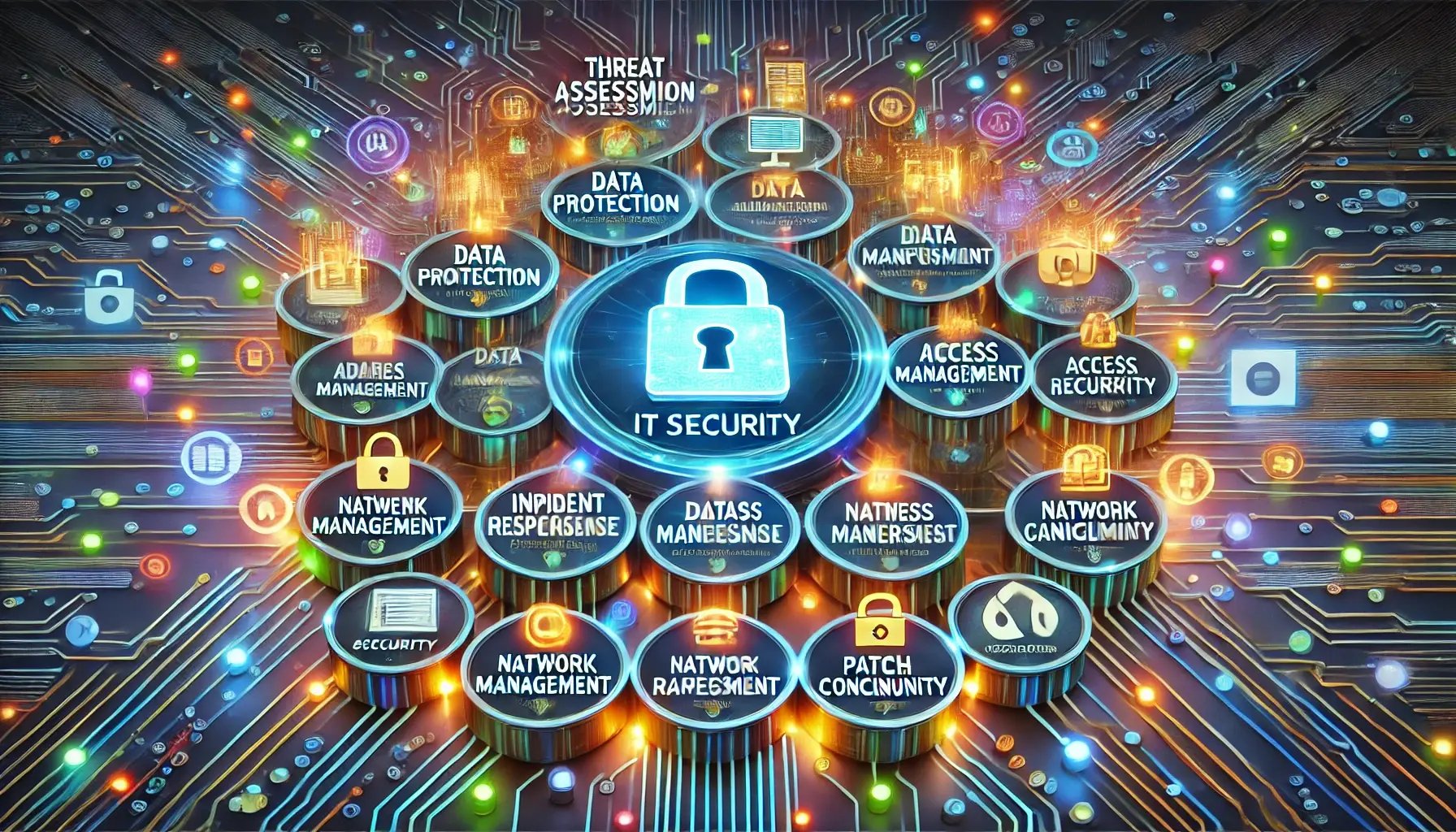Phishing attacks remain one of the most pervasive cybersecurity threats globally, with businesses...
The Cornerstone of IT Security: A Comprehensive Risk Management Strategy
 In today's digital age, IT security is no longer a peripheral concern but a critical component of every business's operational strategy. The rise in sophisticated cyber threats, coupled with the increasing reliance on digital infrastructure, has made it imperative for companies to adopt a holistic approach to IT security. The cornerstone of this approach is a comprehensive risk management strategy that addresses the diverse and evolving threats to an organization's digital assets.
In today's digital age, IT security is no longer a peripheral concern but a critical component of every business's operational strategy. The rise in sophisticated cyber threats, coupled with the increasing reliance on digital infrastructure, has made it imperative for companies to adopt a holistic approach to IT security. The cornerstone of this approach is a comprehensive risk management strategy that addresses the diverse and evolving threats to an organization's digital assets.
This article delves into the essential components of a risk management strategy and explains why each is crucial for robust IT security.
1. Threat and Vulnerability Assessment
Understanding the Threat Landscape
The first step in any effective risk management strategy is to understand the potential threats and vulnerabilities that could compromise the organization's IT infrastructure. Threats can come from a variety of sources, including external hackers, disgruntled employees, and even natural disasters. Vulnerabilities, on the other hand, are weaknesses in the system that can be exploited by these threats.
Regular Assessments
Regular threat and vulnerability assessments allow organizations to identify and address these weaknesses before they are exploited. This involves conducting penetration testing, vulnerability scanning, and using threat intelligence to stay ahead of emerging threats. By proactively identifying these risks, organizations can implement necessary security controls to mitigate them.
2. Data Protection and Privacy
The Lifeblood of the Organization
Data is often referred to as the lifeblood of modern organizations. Protecting this data is paramount, especially with the increasing prevalence of data breaches that can have devastating financial and reputational consequences.
Implementing Strong Encryption
One of the most effective ways to protect data is through encryption. Encrypting data both at rest and in transit ensures that even if unauthorized individuals gain access, the data remains unreadable. Additionally, data loss prevention (DLP) tools can monitor and protect sensitive data from being accidentally or maliciously shared outside the organization.
Access Controls
Access to sensitive data should be restricted to only those who need it to perform their jobs. Implementing role-based access control (RBAC) and regularly reviewing access permissions can prevent unauthorized access and reduce the risk of insider threats.
3. Employee Training and Awareness
Human Error: The Weakest Link
Despite advancements in technology, human error remains one of the leading causes of security breaches. Phishing attacks, weak passwords, and careless handling of sensitive information can all lead to significant security incidents.
Regular Training Programs
To mitigate this risk, organizations must invest in regular training and awareness programs. Employees should be educated on the latest security threats, how to recognize phishing attempts, and the importance of following security best practices. By fostering a culture of security awareness, companies can significantly reduce the likelihood of human error leading to a breach.
4. Incident Response Planning
Preparing for the Inevitable
No matter how robust a company’s security measures are, breaches can still occur. What matters most is how quickly and effectively an organization can respond to and recover from such incidents.
Creating an Incident Response Plan
An incident response plan (IRP) outlines the procedures that should be followed in the event of a security breach. This includes identifying the incident, containing it, eradicating the threat, and recovering affected systems. An effective IRP also includes clear communication protocols and assigns roles and responsibilities to ensure a swift and coordinated response.
Regular Drills and Updates
It’s not enough to have a plan on paper; it must be tested regularly. Conducting incident response drills helps teams practice their roles and identify areas for improvement. Additionally, the plan should be updated regularly to reflect changes in the organization’s infrastructure, personnel, and the threat landscape.
5. Regular Audits and Compliance
Ensuring Adherence to Standards
Compliance with industry regulations and standards is not just a legal obligation but also a key component of a strong security posture. Regular audits help ensure that the organization adheres to these standards and identifies any gaps that need to be addressed.
Beyond Compliance: Building Trust
While compliance is often driven by regulatory requirements, it also plays a crucial role in building trust with customers and partners. Demonstrating that the organization takes security seriously can be a significant competitive advantage, particularly in industries where data protection is critical.
6. Access Management and Authentication
Who’s Got Access?
Controlling access to systems and data is one of the most effective ways to prevent unauthorized activity. Access management involves defining who can access what resources and under what conditions.
Multi-Factor Authentication (MFA)
Implementing multi-factor authentication (MFA) is a critical step in strengthening access controls. MFA requires users to provide two or more verification factors to gain access, making it much harder for attackers to compromise accounts. In addition to MFA, organizations should regularly review and adjust user access levels to ensure that permissions align with job roles.
7. Network Security
The First Line of Defense
Network security is often the first line of defense against cyber threats. A secure network infrastructure protects the flow of data and prevents unauthorized access to systems and information.
Firewalls and Intrusion Detection Systems
Firewalls are fundamental to network security, acting as a barrier between the internal network and the outside world. They monitor and control incoming and outgoing network traffic based on predetermined security rules. Intrusion detection and prevention systems (IDS/IPS) further enhance security by detecting and blocking malicious activities.
Network Segmentation
Segmenting the network into smaller, isolated sections can limit the spread of an attack if one segment is compromised. This approach, known as micro-segmentation, ensures that a breach in one area doesn’t provide easy access to the entire network.
8. Patch Management
Closing the Door on Vulnerabilities
Software vulnerabilities are a common entry point for cyber attacks. Patch management is the process of regularly updating software to fix these vulnerabilities and improve security.
Automating Patch Management
Given the sheer number of systems and applications that need to be updated, automating patch management can help ensure that all systems are kept up-to-date without requiring constant manual intervention. Organizations should establish a routine for deploying patches promptly, especially for critical vulnerabilities.
9. Monitoring and Detection
Constant Vigilance
Continuous monitoring of systems and networks is essential for detecting suspicious activity before it escalates into a full-blown security incident.
Security Information and Event Management (SIEM)
SIEM tools aggregate and analyze logs from various sources across the organization’s IT environment. By correlating events and identifying patterns, SIEM can help detect anomalies that may indicate a security breach. Additionally, real-time alerts enable security teams to respond quickly to potential threats.
10. Business Continuity and Disaster Recovery
Ensuring Resilience
Even with the best security measures in place, disasters can happen—whether due to cyber attacks, natural disasters, or other unforeseen events. Business continuity and disaster recovery (BC/DR) plans are essential for ensuring that critical operations can continue or be quickly restored after an incident.
Regular Backups and Testing
Regular backups of critical data and systems are a cornerstone of any BC/DR plan. These backups should be stored securely and tested regularly to ensure that they can be restored quickly and completely in the event of a disaster. In addition to backups, organizations should also test their BC/DR plans through drills and simulations to identify potential weaknesses and make necessary adjustments.
Conclusion
In the rapidly evolving landscape of IT security, no single measure can guarantee complete protection against cyber threats. Instead, organizations must adopt a comprehensive risk management strategy that addresses all aspects of IT security—from threat assessment and data protection to employee training and incident response. By focusing on these critical areas, companies can not only protect their digital assets but also ensure the resilience and continuity of their operations in the face of evolving threats.
Ultimately, IT security is not just a technical challenge but a strategic imperative that requires ongoing attention, investment, and commitment at all levels of the organization.



.gif?height=200&name=Untitled%20design%20(1).gif)